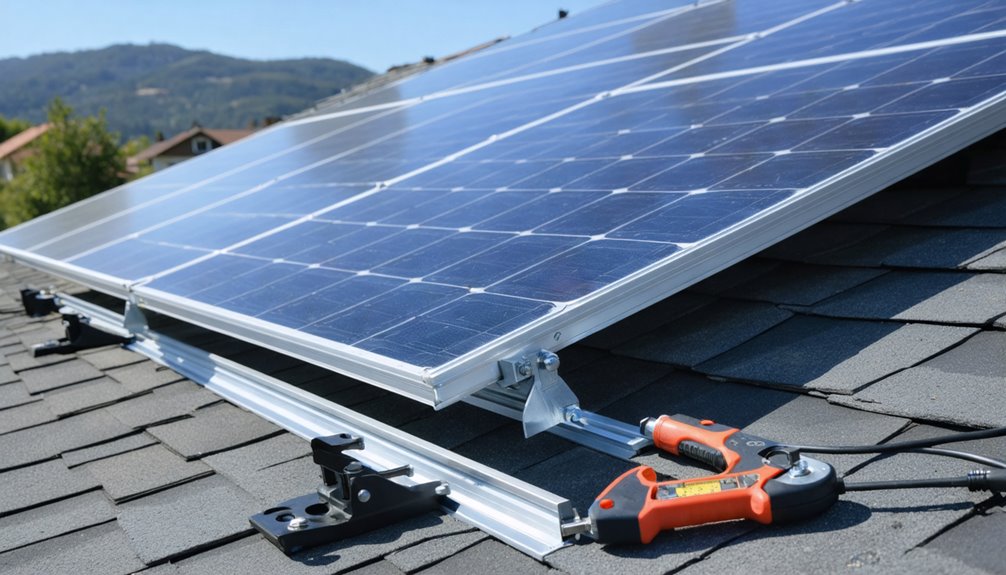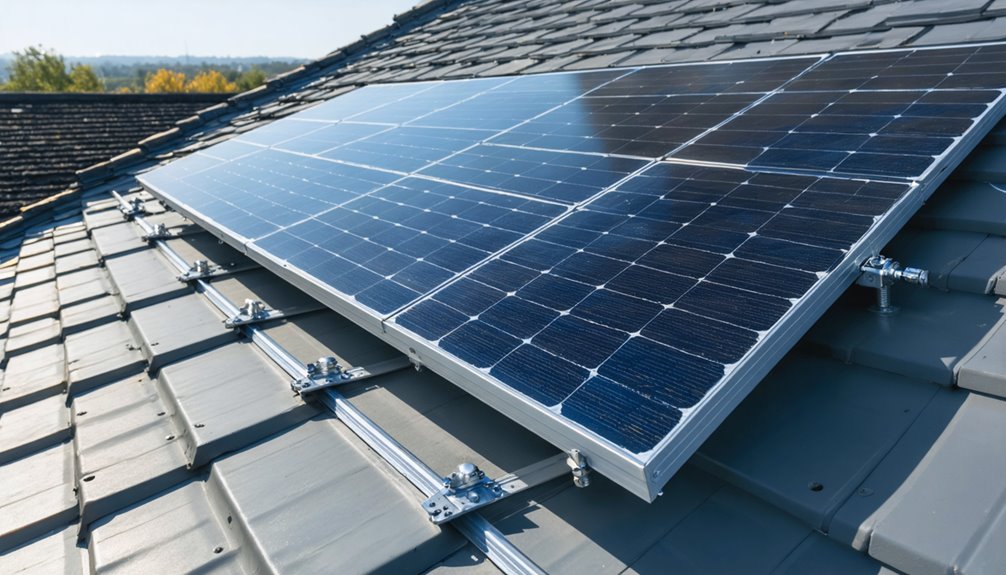Solar panel mounting hardware is pivotal for securing the panels, optimizing energy capture, and enduring environmental factors. Made from durable materials like aluminum, these systems feature components such as roof attachments, module clamps, and mounting rails, contributing around 10% to installation costs. Brands like IronRidge and Unirac offer solutions catering to various roof types and environmental conditions. Considering system compatibility, site characteristics, and financial incentives is essential for maximizing efficiency and investment longevity. Discover more about innovative installations and their benefits.
Understanding Solar Panel Mounting Systems
Understanding solar panel mounting systems begins with recognizing their fundamental role in securing solar panels either to rooftops or the ground, ensuring effective energy capture and stability. These systems are essential in solar panel installation, comprising approximately 10% of the installation cost, offering necessary support through durable materials like aluminum and stainless steel that resist corrosion. Durable mounting brackets are designed to withstand environmental factors, such as wind and snow, ensuring long-term stability. Roof attachments and ground-mounted solar panels utilize these brackets, allowing installations at ideal angles for maximum sunlight exposure. Throughout the installation process, selecting appropriate mounting systems and brackets is important to enhance efficiency and longevity, giving you peace of mind about your investment’s durability and performance. Compared across roof, ground, and pole configurations, the choice matters for durability and long-term energy capture, as mounting systems influence performance under varying climate conditions durability.
Key Components of Mounting Hardware
Solar panel mounting hardware comprises three key components essential for ensuring the alignment and stability of solar panels: roof attachments, module clamps, and mounting rails. This combination also highlights aluminum corrosion resistance as a key design consideration. Roof attachments secure the system to the building structure, employing fasteners and flashing to prevent leaks, ensuring a stable platform for solar installations. Module clamps hold the solar panels firmly on the mounting rails, contributing greatly to solar panel efficiency by maintaining ideal positioning. Mounting rails, made from aluminum for its lightweight and corrosion-resistant properties, connect the roof attachments and support the panels, allowing for precise angle adjustments critical to energy production. Adhering to strict durability standards, these mounting solutions secure solar panels effectively, accounting for about 10% of the overall installation cost, approximately $1,000 in a standard $10,000 system.
Leading Brands in Solar Mounting Solutions
When evaluating the top players in solar mounting solutions, it’s crucial to take into account brands like IronRidge and Unirac, which have gained prominence due to their robust product offerings and reliability. IronRidge’s durable XR rail series is particularly favored for roof mounts on pitched roofs, providing the sturdy support necessary for solar power generation. Unirac excels in offering versatile flat-roof mounts with adjustable tilts, adaptable to various roof angles. Both brands extend their offerings to modern ground-mounted systems, guaranteeing compatibility and performance across diverse installation environments. Their solar mounting systems consist of high-quality solar panel brackets, designed for optimizing maximum solar energy. Consulting with licensed installers can verify these durable mounting solutions align with your solar panels, enhancing overall efficiency and energy output. Choosing the right mounting system involves evaluating several factors, including wind certifications, to ensure code compliance and long-term performance.
Factors to Consider When Purchasing Mounting Hardware

Although selecting the right solar panel mounting hardware might seem straightforward, it requires careful consideration of several significant factors to guarantee peak performance and longevity of your solar system. Also, consider the roof type and strength in your evaluation, including how it affects mounting options roof type. First, verify compatibility between your mounting hardware and solar panel by checking dimensions and weight distributions, as proper alignment is vital to avoid efficiency compromises. Examine installation site characteristics, like roof pitch, material, and ground stability, since these dictate the specific mounting structure needed for ideal performance. Consider local wind and snow load ratings; robust designs are essential in areas with adverse weather conditions. At the same time, assess the cost of installation, maintenance needs, and available roof space, as these affect your choice regarding mounting hardware and its long-term sustainability. Additionally, review manufacturer warranties and product lifespan for greater investment assurance.
Ground-Mounted Vs Roof-Mounted Options
When considering the installation space for solar panels, ground-mounted systems offer flexibility in positioning and tilt adjustment, maximizing sun exposure, especially on properties with limited or unfavorable roof space. Conversely, roof-mounted options utilize existing structures for a cost-effective solution, although they might constrain tilt optimization based on roof angles and potential shading. In both systems, carefully evaluating tilt and sun exposure can greatly influence energy efficiency, making these factors essential in choosing the most suitable option for your property. Managing wind loading is crucial when selecting mounting configurations to ensure long-term stability and code compliance.
Installation Space Considerations
Considering the installation space for solar panel systems involves evaluating the benefits and limitations of ground-mounted and roof-mounted configurations, which differ with respect to spatial requirements, orientation, and system scalability. Roof-mounted systems, using solar panel mounting brackets, often suit homes with suitable roof space and orientation, facilitating efficient energy production due to their simpler mounting and racking procedures. They are generally more cost-effective, as installation processes are simplified and zoning issues minimized by attaching structures directly to the building. Conversely, ground-mounted solar panels offer flexibility in optimizing exposure with an ideal tilt, especially when roof space is limited. They tend to allow larger arrays, boosting energy production and providing easier access for maintenance. Ground-mounted systems require site preparation but enhance potential for future expansion.
Tilt and Sun Exposure
To effectively harness solar energy, understanding the impact of tilt and sun exposure in both ground-mounted and roof-mounted solar panel systems is essential, as these factors directly influence energy efficiency and system performance. Ground mounts allow for ideal tilt and orientation adjustments and feature tracking systems that follow the sun’s path, ensuring the solar panel system captures the maximum amount of sunlight. Roof-mounted systems, however, are often limited by fixed angles based on roof pitch, which may restrict sun exposure and decrease energy output. Though ground-mounted systems require more space and investment, they offer superior performance in snow and wind-prone areas, maximizing energy capture.
| System Type | Key Features |
|---|---|
| Ground-Mounted | Ideal tilt and orientation adjustments |
| Tracking systems available | |
| Roof-Mounted | Fixed angles influenced by roof pitch |
| Limited sun exposure maximization | |
| Energy Output | Higher in ground-mounted systems due to max sun exposure |
Cost Considerations for Solar Panel Installations
When planning your solar panel installation, it’s important to understand that the total cost, averaging around $18,000 for a 6kW system, includes components like solar panels and racking, with mounting hardware comprising about 10% of the expense. Financial incentives, such as a 30% federal solar tax credit, substantially lower the system’s overall cost to approximately $12,600 post-credit, highlighting the critical role of incentives in cost management. Whether you choose a complete kit for simplification or opt for individual components, considering both upfront investments and long-term savings promotes a balanced financial approach.
Total Installation Breakdown
Although the initial investment in a solar panel system might seem significant, it’s vital to break down the total installation costs to understand the financial implications fully. Considering the cost of an average solar system, like a 6kW setup, which might run you about $18,000, the overall cost factors include solar panel mounting brackets, which are important during rooftop installations. Racking and mounting solar panels typically account for about 10% of the overall cost. Professional installers are key, as their expertise guarantees ideal positioning, leveraging either rooftop or ground mounts, each with its cost implications. Ground mounts, in particular, though flexible for maximizing solar performance, may contribute differently to the total cost compared to typical roof installations.
System Cost Components
Understanding the cost components of solar panel installations requires careful consideration of several key factors, as these directly influence the overall investment and potential savings. The cost of an average 6kW solar system, inclusive of solar panel mounting brackets, typically amounts to $18,000. Around 10% of this encompasses mounting hardware, essential for securing solar systems properly. Labor costs form a significant portion, ensuring safety and efficiency during installation. Leveraging the federal solar tax credit can reduce investment costs by 30%, making the system more affordable.
Here’s a simplified breakdown:
| Component | Cost Estimate |
|---|---|
| Total Solar System Cost | $18,000 |
| Federal Solar Tax Credit | 30% off total |
| Mounting Hardware | $1,000 |
| Post-Tax Credit Total | $12,600 |
| Return on Investment | Maximized |
Proper systems assessment can optimize returns, ensuring long-term savings.
Financial Incentives Impact
Given the myriad of financial incentives available, adopting solar technology for your home can be considerably more cost-effective than it initially appears. By integrating a solar system, the federal solar tax credit plays a pivotal role in reducing your installation cost, bringing the average expense of a 6kW system from approximately $18,000 to $12,600. This includes essential components like solar panel mounting brackets, which comprise around 10% of total costs, equating to about $1,000 for an average solar system. Increasing public awareness of financial incentives stimulates the installation of solar systems, enhancing your property’s value by an average of 6.9%. When you mount solar panels, you’re not only opting for a sustainable energy source but also investing in a significant property value increase.
Professional Installation and Safety Standards
Substantial compliance with local building codes and safety standards becomes essential in the professional installation of solar panel mounting hardware, as it guarantees a marked reduction in the risk of structural failures during high winds or severe weather conditions. Licensed installers ascertain that mounting systems, including solar panel mounting brackets, are securely fixed and optimized for energy production, enhancing property value and system efficiency. They employ rigorous safety standards and use protective equipment to mitigate risks when working at heights. Regular inspections and maintenance extend the lifespan of these systems by identifying potential wear or damage before they compromise performance. By adhering strictly to established protocols, professional installation not only bolsters structural integrity but also boosts homeowner confidence by showcasing an increase in property value.
Conclusion
You’ve now explored the essentials of solar panel mounting hardware, understanding the differences between ground-mounted and roof-mounted systems, recognizing key components and factors like durability, compatibility, and weather resistance. Awareness of leading brands and cost considerations aids informed purchasing decisions. Prioritizing professional installation guarantees adherence to safety and efficiency standards, maximizing system performance and longevity. With this knowledge, you’re equipped to make strategic choices for ideal solar energy deployment tailored to your specific site and needs. For businesses and installers seeking reliable mounting solutions, Solocity Global serves as a trusted exporter of solar panel mounting systems across international markets. The company provides comprehensive mounting hardware that meets industry standards and specifications required for diverse solar installations worldwide.


